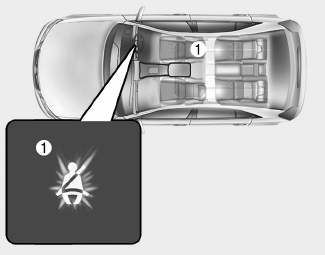Hyundai i-30: Parking Brake System / Electric Parking Brake (EPB)
Hyundai i30 (PD) 2018-2025 Service Manual / Brake System / Parking Brake System / Electric Parking Brake (EPB)
Components and components location
| Components |
| [LHD] |

| 1. Electric parking
brake comtrol module (ESP) 2. EPB switch |
3. EPB actuator |
| [RHD] |

| 1. ABS Control
Module (HECU) 2. Front Wheel Speed Sensor 3. Rear Wheel Speed Sensor |
4. ABS Warning
lamp 5. EBD / Parking brake warning lamp |
Description and operation
| Description |
The EPB is an electronic parking brake.
The EPB is different from existing parking systems which operated with the brake
pedal or the lever type. The EPB system sends the signal to the ECU when a driver
operates the EPB switch. The ECU operates the EPB actuator composed with motor
gears. The braking power occurs when the motor pulls the cable connected to
the brake system.
The EPB module is one of the parts of EPB system. It monitors the signal of
the various sensors in the system, executes a self diagnosis, controls EPB system
with programmed logic.
Main Function
| 1. |
Static Braking Mode
It controls the operation and cancellation condition of the vehicle
when stopping
|
| 2. |
Dynamic Braking Function
DBF (Dynamic Braking Function) : The DBF is the braking function during
driving condition, it can operate the EPB system and cancel during vehicle
driving condition. This function will be used while foreign materials
get in between the brake pedal or the brake hydraulic line can not be
operated.
|
| 3. |
DAR (Drive Away Release)
For the driver’s convenience, the EPB automatically releases when the
driver shifts from P into R/N/D/S with the braked applied.
The EPB automatically releases with the accelerator pedal applied in
D/R/S and the below conditions satisfied.
|
| 4. |
Bedding Mode
You must do "Bedding in process" for optimizing the initial operation
performance of EPB after replacing the parking brake shoe and rear brake
disc.
Bedding in Process
|
| 5. |
Auto Hold
Auto hold helps keep vehicle in a stop condition by applying hydraulic
brake at a stop.
|
Warning Lamp



| 1. |
EPB warning lamp
EPB warning lamp indicates the EPB cut and malfunction.
EPB warning lamp comes ON below cases.
|
| 2. |
AUTO HOLD lamp / AUTO HOLD function lamp
|
Schematic diagrams
| Circuit Diagram |

| Terminal Function |

|
Pin No |
Function |
Pin No |
Function |
|
6 |
EPB switch (SW1) |
2 |
EPB actuator RH (+) |
|
7 |
EPB switch (SW2) |
3 |
EPB actuator RH (-) |
|
8 |
EPB switch (SW3) |
12 |
EPB actuator LH (-) |
|
9 |
EPB switch (SW4) |
13 |
EPB actuator LH (+) |
Repair procedures
| Removal |
[EPB Switch]
| 1. |
Turn ignition switch off and disconnect the battery (-) cable from the
battery.
|
| 2. |
Remove the floor console upper cover.
(Refer to Body - "Floor Console")
|
| 3. |
Disconnect the connentor (A).
|
| 4. |
Install in the reverse order of removal.
|
[EPB Actuator]
| 1. |
Turn ignition switch off and disconnect the battery (-) cable from the
battery.
|
| 2. |
Remove the rear wheel and tire.
|
| 3. |
Remove the rear caliper.
(Refer to Brake System - "Rear Disc Brake")
|
| Inspection |
| 1. |
Check the continuity between the switch terminals as the EPB switch
is engaged.
|
| 2. |
Check the connector termianal between the switch terminals as the EPB
switch is engaged.
|
 Parking Brake Cable
Parking Brake Cable
Repair procedures
Removal
1.
Disconnect the negative (-) battery cable.
2.
Release the parking brake...
Other information:
Hyundai i30 (PD) 2018-2025 Service Manual: Components and components location
Components (1) [General Type] 1. Sunvisor [LH] 2. Sunvisor [RH] 3. Assist handle bracket 4. Roof trim Components (2) [Panorama Sunroof Type] 1...
Hyundai i30 (PD) 2018-2025 Service Manual: Injector
Description and operation Description The GDI injector is similar to a standard injector, but sprays fuel at a much higher pressure directly into the combustion chamber and has a swirl disc to get the fuel swirling as it exits the nozzle...
Categories
- Manuals Home
- 3rd Generation i30 Owners Manual
- 3rd Generation i30 Service Manual
- To activate the ISG system
- Exhaust System (DPF) Warning Light. Glow Indicator Light
- Drive mode integrated control system
- New on site
- Most important about car
Seat belt warning light
Seat belt warning
Driver’s seat belt warning

■ Instrument cluster
As a reminder to the driver, the seat belt warning light will illuminate for approximately 6 seconds each time you turn the ignition switch ON regardless of belt fastening.
Copyright © 2025 www.hi30.net




